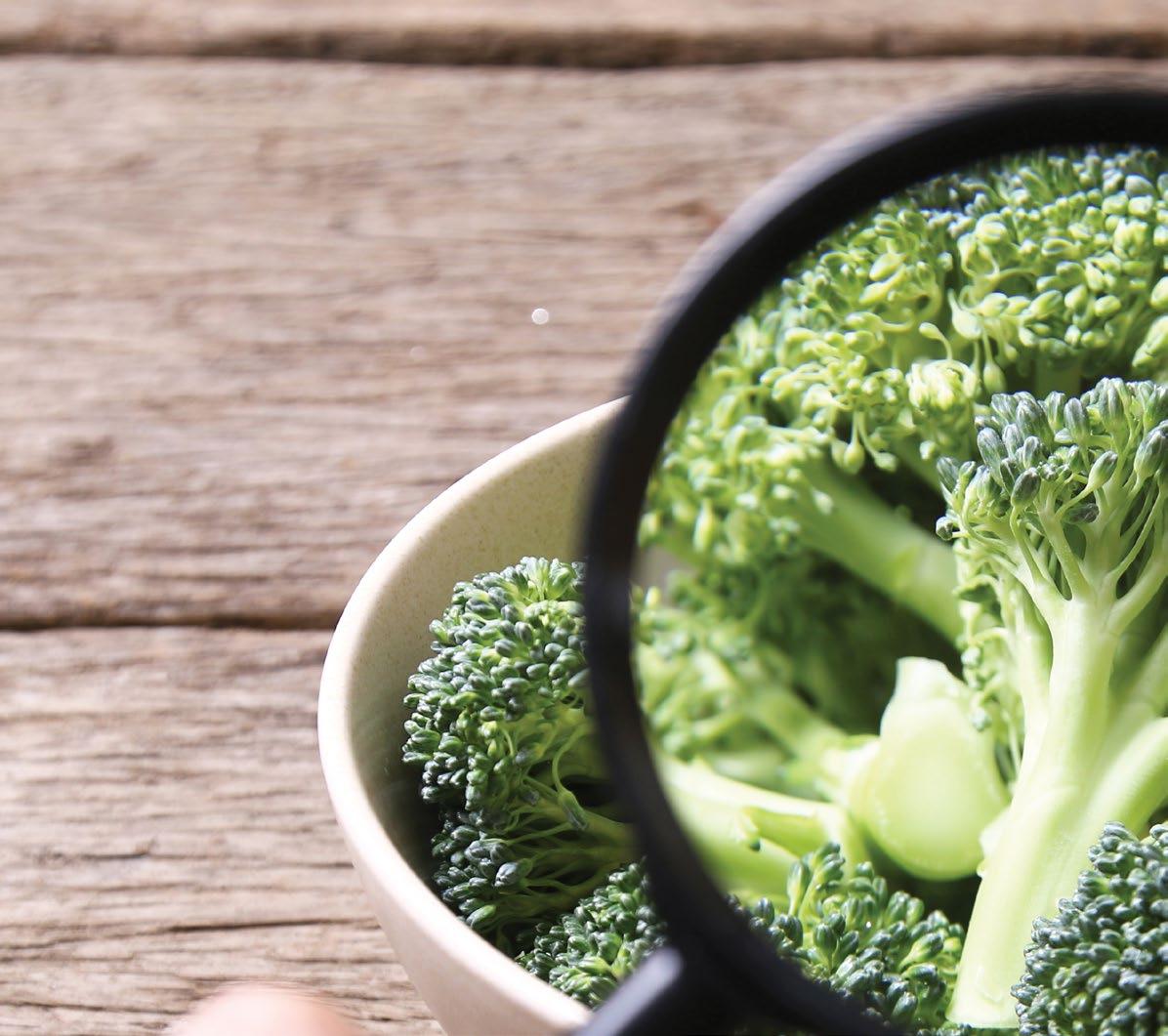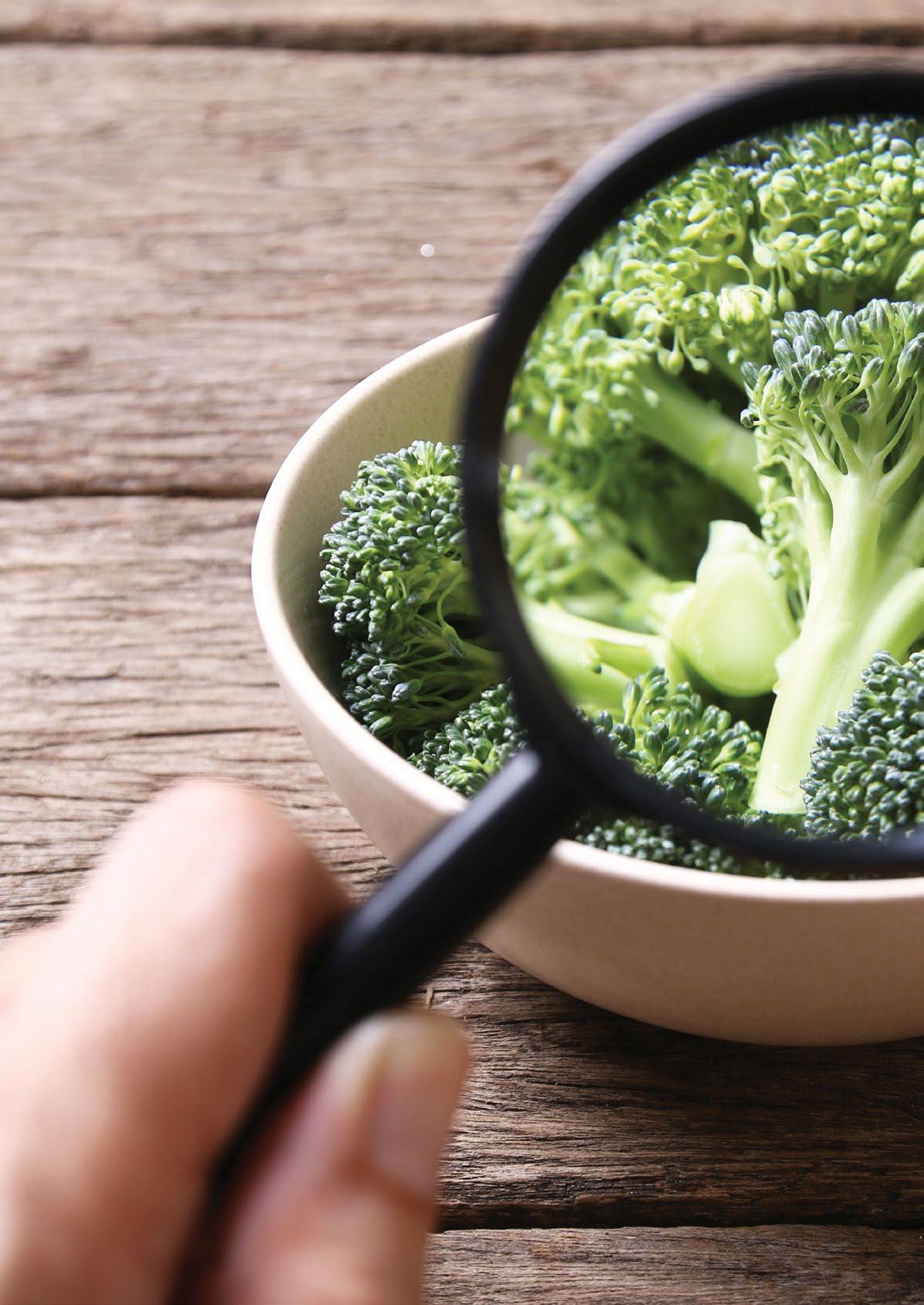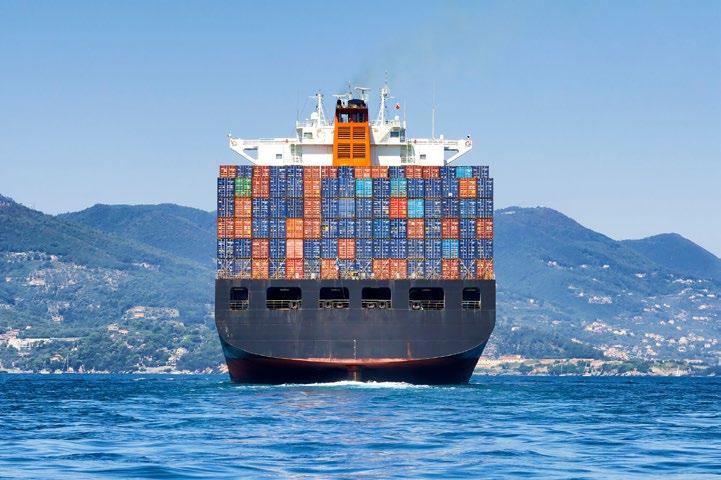
12 minute read
Fostering food safety
Fostering and enhancing food safety
in the vegetable industry
Advertisement

3 SMALL scale operations may not have a food safety system, even though legally they should.
PROJECT VG13020 WAS UNDERTAKEN BY RM CONSULTING GROUP (RMCG)
Project VG13020 aimed to analyse the current level of food safety management in the vegetable industry, including the key risks.
In their report, the research team emphasised the critical importance of managing food safety, noting that food safety issues affect the public’s perception of safety as much as they affect people’s actual health. They also noted that media reports about foodborne illnesses can be sensationalist and misleading, and this combination of factors could cause significant damage to the vegetable industry, should an incident occur, and communication is not managed well. Following extensive research, the team identified a number of key risk factors for the vegetable industry. First, they found that although all food businesses that supply food directly to the public must, by law, have a food safety program in place, not all vegetable growers are aware that they fall under this regulation. Lead researcher Dr Doris Blaesing from RMCG confirmed this. “Small scale operations may not have a food safety system, even though legally they should,” she said.
Costs and the complexity of food safety systems are often mentioned as reasons. “This can put the entire industry at risk.”
Next, the researchers found that the rules and regulations around food safety were inconsistent across the country’s states and systems. This means that vegetable growers who operate across state borders must comply with different interpretations of the Food Standards Code. Another important finding was that major retailers and processors required growers to be certified under their own food safety systems, meaning that many growers had to comply with up to six different systems. This puts a high demand on growers’ costs and does not necessarily improve food safety outcomes.
New guidelines have been developed to better manage the risk from organic soilamendments. The researchers highlighted that vegetables can become contaminated at any stage during the supply chain. Poor food safety management in any part of the chain may have repercussions for growers if vegetables are implicated in a foodborne illness outbreak. Finally, organic vegetable farming was found to have some potential associated risks. “Organic producers often use organic soil amendments, including manures,” Dr Blaesing said.
3 RESEARCHERS highlighted vegetables can become contaminated at any stage during the supply chain.

“This may pose a risk to the entire industry if the amendments have not been composted properly and used ahead of growing a high-risk crop that is eaten raw. Especially if the business has no food safety system in place.”
Recommendations
conditions, and, if sufficient research HARPS is a retailer-led scheme does not exist, that it be undertaken. designed to assist with compliance to A third recommendation was that the industry foster awareness of food safety risks and legal requirements amongst food safety, legal and trade legislation for suppliers to the major grocery retailers in Australia. growers and supply chain members. However, many producers who supply a Based on the analysis, the project The team advised extension programs to assist members from different range of markets still have to run more than one food safety system. made recommendations on how to backgrounds who currently do not have Since the project was completed, new minimise the identified risks. The first suitable measures in place. guidelines have also been developed to recommendation was that the different food safety certification systems be streamlined in terms of record keeping and auditing. Much of this has since been achieved. Additional recommendations were made to support the industry in its pursuit of providing safe food. These included educating the public, since, better manage the risk from organic soil amendments. The Australian vegetable industry has also invested in a Crisis Management Plan, overseen by AUSVEG, to manage industry crises and mitigate the “We recommended that these third-party certification schemes use the FAO/ WHO (Food and Agriculture Organization of the United Nations/World Many producers who supply a range of markets may have to run more than one food safety system. according to records, most food related illnesses are due to poor food handling in the home. reputational damage that a crisis can inflict on the broader industry, including as a result from issues with food safety. Health Organization) hazard The team also advised categorisation for fresh produce, investigating options to gather to characterise risks and then align the further information and data on food safety requirements to these risks,” practical and effective food safety quality Dr Blaesing explained. assurance needs from and for vegetable Secondly, the team advised that the producers. critical limits used in food safety Background schemes in Australia be reconsidered to determine which limits should be newly established for Australian conditions. As a result of this project, the VegPRO project (VG15028) last year produced a food safety training e-learning course “Not all aspects of food safety quality for employees, which was well received assurance systems are based on by vegetable producers. Australian R&D data,” Dr Blaesing said. To deal with the issue of growers The team advised that a review be needing to comply with multiple undertaken of scientific research that food safety systems, HARPS has has been completed under Australian been introduced.
export fReight
WWW.GO2TIGERS.COM
CONTACT JASON RADFORD 0412 107 405 | JASON.RADFORD@GO2TIGERS.COM PERTH INTERNATIONAL AIRPORT
MORE INFORMATION
For more information, please contact Dr Doris Blaesing at dorisb@rmcg.com.au. For more information on HARPS, visit
harpsonline.com.au
The final report for this project is available on InfoVeg. Readers can search ‘VG13020’ on the InfoVeg database: ausveg.com.au/
infoveg/infoveg-database

This project has been funded by Hort Innovation using the vegetable research and development levy and funds from the Australian Government. For more information on the fund and strategic levy investment visit horticulture.com.au


Tigers are the largest perishable freight forwarder in Western Australia with the ability to handle export by air and sea. With a full range of facilities close to Perth Airport Tigers can handle all of your perishable freight requirements including air freight security screening, phytosanitary inspections and certification, fumigation services cold storage facilities.
FLOOD RECOVERY CHECKLISTS — VIETNAMESE TRANSLATION
Danh mục kiểm tra sau lủ lục cho nông trang
VÕ THẾ TRUYỀN CHUYÊN VIÊN KHUYẾN NÔNG VIỆT NAM, HIỆP HỘI RAU CẢI TÂY ÚC
Trong ngày 4 và 5/2/2021 Carnarvon đã hứng lượng mưa gấp đôi vủ lượng trung bình hàng năm kèm theo gió mạnh và nước sông Gascoyne dâng cao đến 7,11 m gây lủ lụt, ngập úng và bị cô lập.
Mặc dù đánh giá sơ bộ cho thấy đến 80% nông trang ít bị hoặc không bị ảnh hưởng của nước sông dâng cao, nhưng toàn bộ 100% đất nông nghiệp địa phương bị úng nước và các nông trang phía tây ngã tư Bibbawarra trên đường North River Road và dọc theo phố Robinson bị nước ngập đáng kể. Dưới đây là một số lưu ý mà các nông trang rau quả nên cân nhắc khi thực hiện các hoạt động khôi phục sau lủ lụt trong khi hy vọng trời sẽ nắng tốt trong các tuần tới. Các thông tin này có thể tới không kịp lúc các nông gia đang gấp rút thực hiện các hoạt động khôi phục sau lủ. Tuy nhiên vẫn có nhiểu điểm thiết thực cho công việc quản lý và hoạch định nông trang lâu dài.
1. Không gian sống và nhà xưởng. • Điều đầu tiên là kiểm tra cẩn thận xem có động vật hoang dã, rắn rít trong và chung quanh nơi ở sau lủ. Do các đông vật này có khuynh hướng di chuyển lên chổ cao khi lủ lụt, chúng có thể vào nơi ở của con người. việc kiểm tra này là rất cần thiết. Nếu phát hiện chúng thì không nên tự bắt hay xua đuổi, nên liên hệ với dịch vụ khẩn cấp: Carnarvon Volunteer Fire and Rescue Service. 344 Robinson Street Carnarvon, WA, Australia 6701, (08) 9941 1013. • Tháo cạn các vũng nước đọng quanh nhà vì đây là nơi lý tưởng cho muổi sinh sản. • Kiểm tra và vệ sinh nhà xưởng. Tình trạng ngập úng hay nước chảy gây sói lở chân tường có thể gây ảnh ưởng đến nền móng và kế cấu chịu lực công trình. Cẩn thận xem xét móng, ngạch, tường, khung mái…xunh quanh trước khi vào vệ sinh bên trong. Nếu phát hiện bất thường thì cần nên tư vấn các dịch vụ xây dựng chuyên nghiệp. Nền nhà xưởng thường bị phủ bùn sau lủ. Nên tranh thủ tẩy rửa trước khi lớp bùn khô.
• Thường xuyên theo dõi thông báo về khả năng cấp nước và chất lượng nước của địa phương. • An toàn thực phẩm Thời điểm ngập lụt tại Carnarvon xảy ra vào cuối mùa nên không có lượng thu hoạch lớn hàng hóa rau cải thương mại. Tuy nhiên vẫn còn một vài hộ thu hoạch bí rợ và dưa hấu. Ngoài ra, nhiều nông trang có tập quán duy trì vườn rau xanh quanh nhà cho gia đình sử dụng. Các loại này có thể bị nước ngập dẫn đến các quan ngại về nguy cơ an toàn thực phẩm. Với tình trạng một số nơi cống 2. Các thiết bị điện rảnh và hầm vệ sinh bị ngập lụt, nước lụt có nguy cơ bị
Một số nông trang bị ngập lụt và nằm trên đường nước thoát lủ bị ảnh hưởng sói mòn và trôi đất có thể làm lộ ra hệ thống dây điện và ống nước chôn ngầm. Ngập lụt có thể ảnh hưởng đến nền móng và làm suy yếu độ bền kết cấu của tòa nhà. nhiểm khuẩn. Không nên ăn hay trao đổi buôn bán các sản phẩm rau xanh bị tiếp xúc với nước lụt trước khi chúng được xác định an toàn thông qua xét ngiệm nguồn nước và • Nên nhờ dịch vụ chuyên xét nghiệm sản phẩm. nghiệp kiểm tra các thiệt hại và kiểm tra tất cả tủ điện, bảng điện, 4. Nhiên liệu, nông dược phân bón cầu chì, cầu dao, công tắc. bị ngập hay rỏ rỉ • Nước ngập có thể làm cho các mô-tơ bơm nước phủ bùn gây ra tình trang nối tắt hay rò rỉ điện nguy nhiểm. Nếu mô-tơ bị nghập thì Nếu phát hiện tình trạng nhiên liệu, nông dược phân bón bị ngập hay rỏ rỉ: không nên vận hành sử dụng trước • Cô lập khu vực bị ảnh hưởng. khi được thợ điện chuyên nghiệp • Trang bị quần áo, dụng cụ bảo hộ kiểm tra an toàn. khi kiểm tra mức độ ảnh hưởng. 3. Hệ thống nước sạch • Khi cảm thấy tình hình nghiêm trọng: liên hệ dịch vụ khẩn cấp địa
Tại Carnarvon hệ thống cấp nước phương để dược hướng dẫn, giúp sinh hoạt được dẫn đến từng nông đở tránh ảnh hưởng lan rộng. trang, tuy nhiên cũng nên lưu ý: • Kể cả khi nông gia có khả năng • Kiểm tra hư hại hệ thống ống nước tự xử lý, dọn dẹp thì cũng phải có sau lủ để kiệp thời khắc phục trách nhiệm thông báo với cơ quan • Xúc rửa hệ thống ống nước. chuyên môn địa phương.

TRAN PHOTO © SU
3 NỀN kho bị ảnh hưởng khi đất bị rửa trôi do lụt
• Khi xử lý, dọn dẹp: cần phải xem như thể là các nơi nầy đã bị ô nhiểm, tránh phơi lộ mắt, da, hô hấp bằng cách trang bị quần áo, dụng cụ bảo hộ phù hợp. Thông tin hướng dẫn chi tiết có trong tài liệu tập huấn quản lý rủi ro trong sử dụng nông dược AusChem. • Trong trường hợp rò rỉ nhiên liệu xăng dầu nghiêm trọng • Thông báo đến dịch vụ khẩn cấp
Carnarvon Volunteer Fire and
Rescue Service. • Tạo điều kiện thông thoáng để giảm hơi xăng dầu tích tụ dể rủi ro cháy nổ hay gây hại sức khỏe. • Mang bao tay cao su, ủng cổ cao, và mặt nạ lọc không khí vì phơi nhiểm hơi xăng dầu gây hại sức khỏe. • Dùng các loại chất thấm để thu gom xăng dầu rò rỉ. • Loại bỏ các vật liệu xốp rổng bị thấm xăng dầu mà không tẩy rửa được.
Liên hệ cơ quan quản lý chất thải
Carnarvon để được hướng dẫn chi tiết:
Waste Management Division
Carnarvon 3 Francis Street, Carnarvon, WA 6701 p: (08) 9941 0000 e: shire@carnarvon.wa.gov.au 5. Đất trồng trọt
Những nông trang bị nước lụt nên lưu ý: • Trang bị bảo hộ an toàn khi dọn dẹp rác rưởi, cây cối do nước lủ trôi vào. • Nên xét nghiệm đất vì đất bị ngập lụt có thể bị rửa trôi dinh dưỡng,
nhiểm mầm bệnh cho người hay nhiểm kim loại nặng. Nhiều nông trang vẫn còn ni-lon trên luống trồng cần phải được dọn dẹp để chuẩn bị cho mùa vụ mới, tuy nhiên một khi đất bị ngập bảo hòa nước sẽ mất thời gian khá lâu để khô ráo. Vì vậy: • Tránh hoạt động cơ giới trên đất còn ướt và hạn chế tải nặng gây nén dẽ đất. Thông thoáng đất thật nhanh là quan tâm hàng đầu của nông gia sau lủ lụt, có thể ríp nhẹ đất giửa luống để phá vở lớp đất nén dẻ do cơ giới hoạt động thời gian qua nhằm tăng cường thông thoáng và độ thấm cho đất. Lưu ý nếu ríp sâu cũng không cải thiện cấu trúc đất lâu dài và có thể gây suy giảm thành phần hửu cơ trong đất trong khi hửu cơ giúp cải thiện tính thấm của đất. 6. Để ý bệnh hại hoa màu
Mặc dù lủ lụt gây ngập nước có thể giúp tiêu diệt phần nào các loại côn trùng gây hại có một phần vòng đời sinh trưởng trong đất như bọ trĩ (bù lạch), đất úng nước lại dể bộc phát bệnh hại hoa màu. Phythothora và
Pythium (gây thối rể) phát triển mạnh trong điều kiện đất ướt. Bệnh này có thể trở thành vấn đề trên các nông trang bị úng nước kéo dài. Hảy liên hệ các nhà nông học địa phương để được giúp đở tư vấn về quản lý sâu bệnh hại hoa màu sau lủ lụt.
THÊM THÔNG TIN
Võ Thế Truyền, Chuyên viên phát triển vùng, (08) 9486 7515, Di động 0457 457 559,
truyen.vo@vegetableswa.com.au











